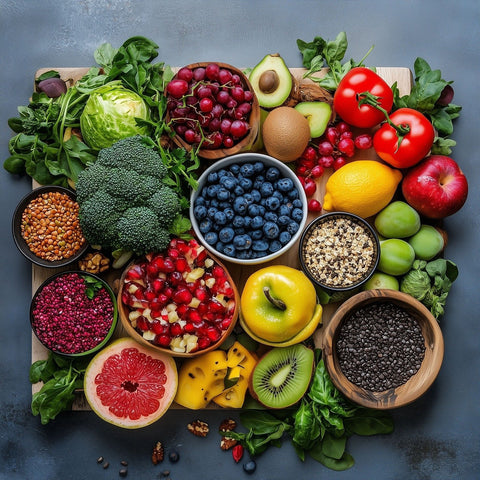Disclaimer:
The information provided is for educational purposes only and should not replace professional medical advice. Always consult a healthcare provider for personalized recommendations.
Lessons from the Eating Habits of the World’s Longest-Living Populations
What if the secret to living a longer, healthier life lies not in expensive supplements or complicated diets, but in the simple eating habits of people in specific parts of the world? These places, known as Blue Zones, are home to the longest-living populations on the planet. From the rugged mountains of Sardinia, Italy, to the serene islands of Okinawa, Japan, these regions offer invaluable insights into how diet can support longevity and well-being.
Let’s explore the common dietary practices in Blue Zones and what we can learn to apply to our own lives.
What Are Blue Zones?
The term Blue Zones was coined by Dan Buettner, a National Geographic researcher, to describe regions where people consistently live longer than average and maintain remarkable health well into their 90s and 100s. These regions include:
-
Okinawa, Japan
Known for their plant-based diet and sense of purpose (ikigai). -
Sardinia, Italy
Celebrated for their wine, whole grains, and close-knit communities. -
Nicoya Peninsula, Costa Rica
Famous for their beans, tortillas, and positive outlook on life. -
Ikaria, Greece
Home to a Mediterranean diet rich in olive oil, vegetables, and herbal teas. -
Loma Linda, California (USA)
A community of Seventh-day Adventists who prioritize a plant-based diet and Sabbath rest.
Lessons from Blue Zone Diets
1. A Plant-Based Foundation
Across all Blue Zones, the majority of calories come from plants. Diets are rich in vegetables, fruits, whole grains, legumes, and nuts, while meat is consumed sparingly, often reserved for special occasions.
What You Can Do:
- Fill half your plate with vegetables at every meal.
- Incorporate more beans, lentils, and chickpeas as affordable, protein-rich staples.
- Choose whole grains like brown rice, quinoa, and whole-wheat bread over refined options.
2. Moderate Protein, Mainly from Plants
Blue Zone diets are moderate in protein, and most of it comes from plant-based sources. Animal protein, when included, is often fish or small amounts of locally raised meat.
What You Can Do:
- Swap meat-based meals for plant-based alternatives a few times a week.
- Try recipes that feature tofu, tempeh, or legumes as the star ingredient.
3. Healthy Fats
In Blue Zones, fats primarily come from nuts, seeds, and oils like olive oil, which are rich in heart-healthy monounsaturated fats.
What You Can Do:
- Use olive oil as your main cooking oil or as a dressing for salads.
- Snack on a handful of unsalted nuts daily to support heart health.
4. Mindful Eating and Portion Control
People in Okinawa practice the principle of hara hachi bu, eating until they’re 80% full. This mindful approach prevents overeating and supports healthy digestion.
What You Can Do:
- Eat slowly and pay attention to your body’s hunger and fullness cues.
- Serve meals on smaller plates to help control portion sizes.
5. Whole, Unprocessed Foods
Blue Zone diets are remarkably free from processed and packaged foods. Meals are prepared using fresh, seasonal ingredients, often grown locally.
What You Can Do:
- Minimize consumption of processed snacks, fast food, and sugary drinks.
- Shop at farmers’ markets or prioritize seasonal produce when grocery shopping.
6. Beans as a Daily Staple
Beans, lentils, and peas are cornerstone foods in all Blue Zones. They are affordable, packed with nutrients, and provide a steady source of energy.
What You Can Do:
- Add beans to soups, salads, or as a side dish.
- Experiment with dishes like hummus, lentil stew, or black bean tacos.
7. Moderation with Alcohol
In Sardinia and Ikaria, moderate consumption of wine—typically enjoyed with meals—has been linked to better heart health and social connection. However, drinking in excess is not a part of the lifestyle.
What You Can Do:
- If you drink alcohol, do so in moderation (e.g., one glass of wine with dinner).
- Avoid binge drinking or using alcohol as a stress reliever.
8. Strong Community Bonds
While not strictly a dietary habit, the social aspects of eating in Blue Zones cannot be overlooked. Meals are often shared with family and friends, fostering connection and reducing stress.
What You Can Do:
- Make mealtime a social activity by eating with loved ones when possible.
- Limit distractions like phones or TV to focus on the experience of eating.
Key Takeaways
The diets of Blue Zone communities are simple, sustainable, and deeply tied to their cultures and environments. They prioritize plant-based foods, healthy fats, and fresh, whole ingredients while practicing mindful eating and fostering strong social connections.
A Sample Blue Zone-Inspired Meal Plan
Breakfast:
Oatmeal topped with fresh fruit, nuts, and a drizzle of honey.
Lunch:
A hearty lentil soup with a side of whole-grain bread and a green salad dressed with olive oil and lemon.
Dinner:
Grilled vegetables, a small portion of fish, and a serving of beans or chickpeas.
Snack:
A handful of almonds or walnuts and herbal tea.
Final Thoughts: Adopting the Blue Zone Way
The lessons from Blue Zone diets are more than just a guide to what to eat—they’re an invitation to rethink how we approach food and life. By incorporating even a few of these principles into your routine, you can enjoy not only better health but also a deeper connection to your meals, your community, and your overall sense of well-being.
Ready to take your first step toward a Blue Zone-inspired lifestyle? Start small, stay consistent, and remember: every bite is an opportunity to nourish not just your body, but your life.




